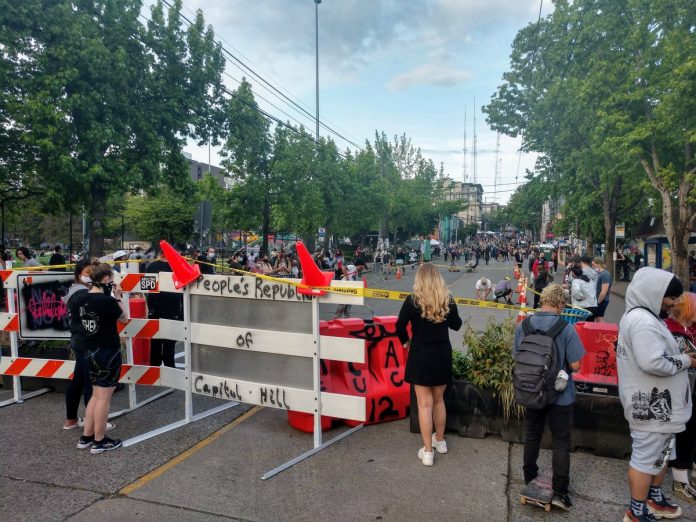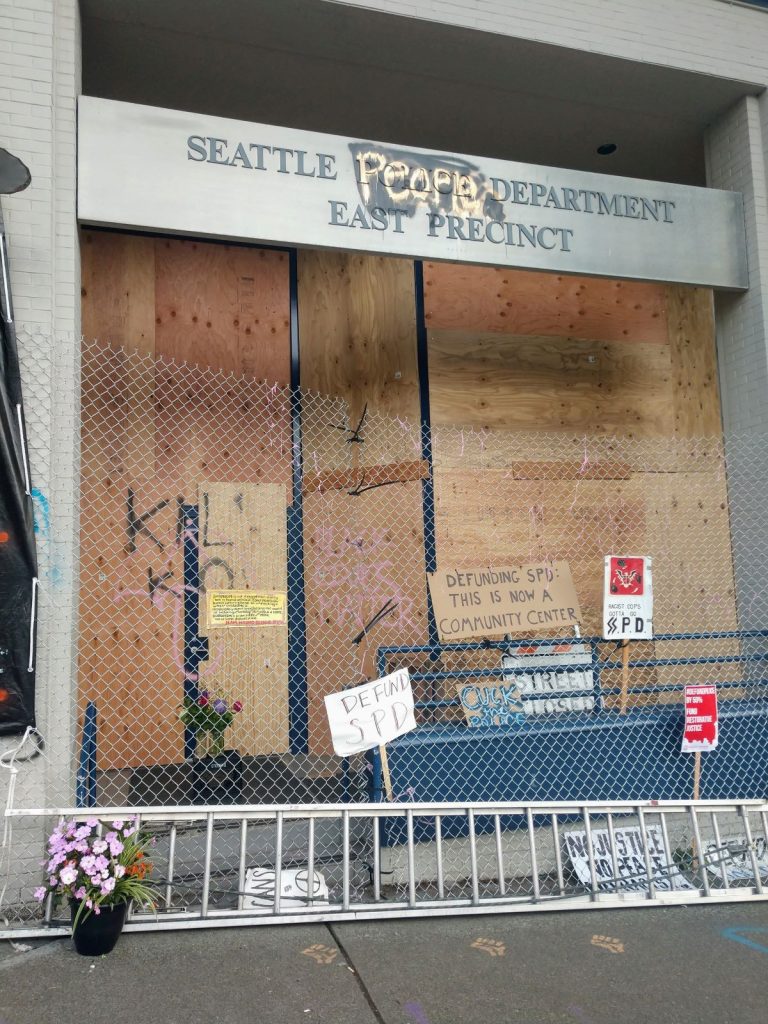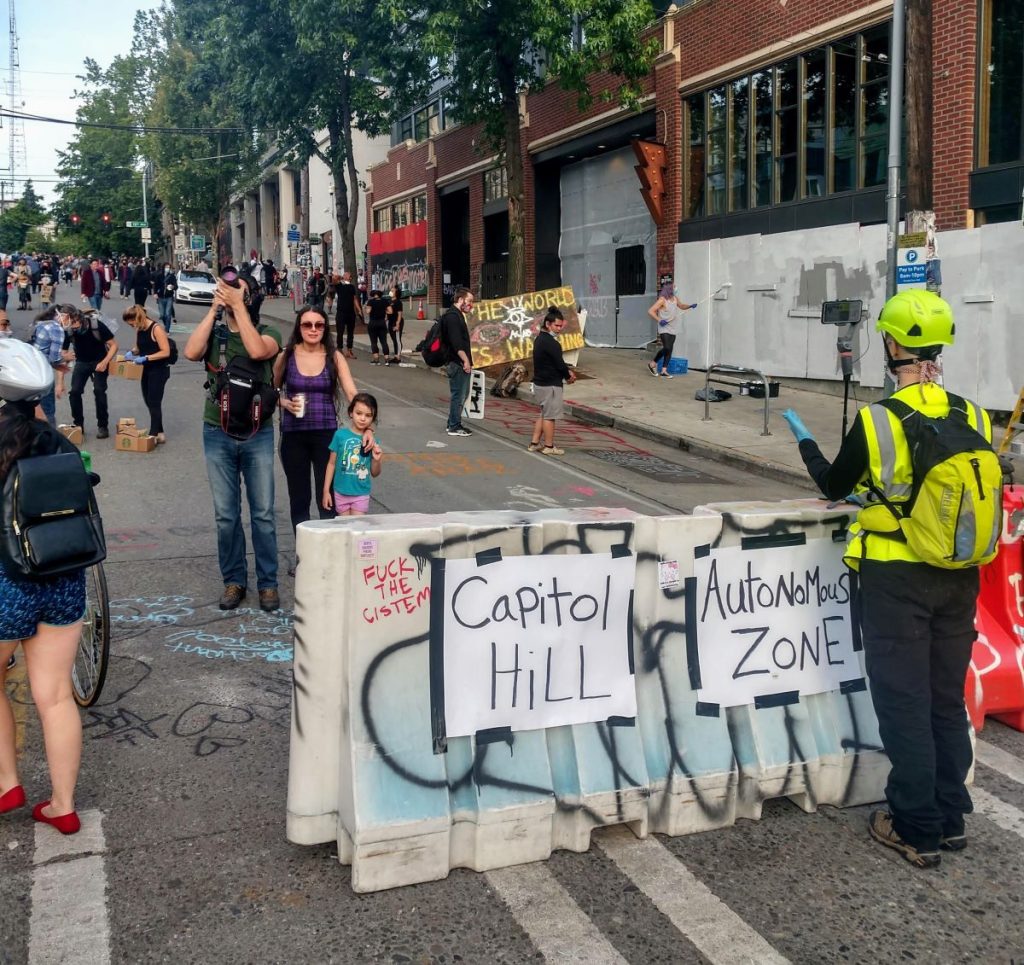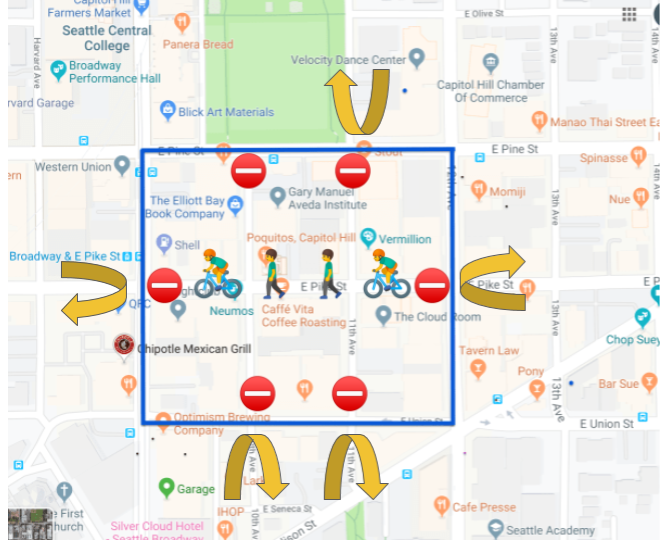
Like a phoenix rising from an ashy war zone, Capitol Hill Autonomous Zone (“CHAZ”) emerged after the Seattle Police Department (SPD) abandoned the East Precinct. To many Capitol Hill residents, it’s a big improvement over the nightly police clashes that clouded their neighborhood in tear gas, pepper spray, and ear-splitting blast balls. Since police left, it’s been peaceful. Still, what is the future for this fledgling “free zone” where a militarized police bunker has been shuttered and the surrounding blocks have become “part street festival, part commune” as The New York Times put it?
Populated by a mix of anarchists, socialists, police abolitionists, and probably some normies too, CHAZ doesn’t have a leadership structure, but one sign on the East Precinct building did hint at a shared vision: “This is now a community center.” Emphasizing the point, the “Seattle Police Department” sign has been spray painted over to read “Seattle People’s Department.”

In a way, the blocks surrounding East Precinct are already serving in a community center capacity. A stage has been assembled to host poetry readings, speeches, teach-ins, and a screening of Ava DuVernay’s 13th. There’s free food and water. Houseless folks have pitched tents finally expecting the police to leave them in peace in this one corner of the city as homeless sweeps march on elsewhere. Protesters painted “Black Lives Matter Way” in big block letters along Pine Street, and people are constantly adding to the collection of street art. The smell of spray paint hangs in the air as you walk around. It’s not a fresh smell, but it sure beats pepper spray.
The mood is calmer–like a raging storm has lifted–but certainly folks are bracing themselves for the return of riot police. In fact, Police Chief Carmen Best broadcast a defiant speech to officers saying the retreat wasn’t her call, pledging to reclaim the building, and reaffirming sketchy police narratives, such as a claim that they’d received credible arson threats to the building. (No fires so far, Chief.)
‘Thelma and Louise moment’ press conference
Mayor Jenny Durkan and Chief Best held a press conference this afternoon and neither took responsibility for the decision to pull out of East Precinct (video here). Apparently, Mayor Durkan ordered the barricades to come down since they had become “a flashpoint”–which is the understatement of the century (see video below). Without the barricade, police decided to abandon the building, though apparently without the order of the Chief or the Mayor. Chief Best wants to reoccupy the East Precinct, claiming that response times had tripled in the precinct. But Mayor Durkan doesn’t seem interested in putting up police barricades again, so police would have to work out a peace with protesters and prove they have a functional de-escalation strategy.
Despite their differences over the East Precinct retreat, Mayor Durkan and Chief Best continue to stand together. In fact, Mayor Durkan joked they had considered a “Thelma and Louise” moment but neither would resign and both expressed faith in each other. Chief Best continue to allude to “credible threats” to the safety of officers, but revealed no serious injuries among the ranks although there had been minor scrapes and the like. It also appears rumors, that SPD started, that CHAZ was shaking down business for protection money, no businesses could be found to speak to reporters or file a police report. Chief Best then seemed to put the blame on back on the media.
It’s hard to imagine how police will peacefully reclaim East Precinct, particularly when they remain unrepentant and double-down on the rightness of their brutal tactics and deceptions. Protesters are demanding real concessions, and police leadership is digging in rather than engaging with substantive demands. Mike Solan, who is president of the Seattle Police Officers Guild or SPOG, has insisted tear gas is necessary to control protesters even as the Seattle City Council appears poised to enact a ban with a likely unanimous vote. If they’re not even willing to back down on tear gas, which is banned in warfare via the Geneva Convention, it’s hard to see how they’ll address any protester demands at all.
What should become of CHAZ?
Many of the protesters’ demands go beyond SPD’s purview and are directed toward elected leaders. Some protesters put together a CHAZ website, which had an extensive list of demands that range from completely defunding SPD to “the de-gentrification of Seattle starting with rent control.” The vision seems to take the ground-up people-centered movement citywide–with more agency, freedom, and resources for disadvantaged communities.

One outcome of CHAZ’s formation was effectively the Capitol Hill Superblock emerged overnight. Councilmembers Teresa Mosqueda and M. Lorena González proposed a superblock back in 2019, as I mocked up below. Councilmember Mosqueda took notice and dubbed it the “Capitol Hill Auto-no-más Zone.” “We’ve have been calling for a super block in this region for a while–streets for people and bikes, local shops and food vendors, childplay areas and limiting cars to just delivery, distribution and local residents,” Mosqueda tweeted. “Could this be the *Auto-No-Mas* Zone we’ve been waiting for?”

A motorist who crashed into a protester outside West Precinct crushing a bike on Wednesday proved the point that car-free areas where people are congregating, especially to protest, are a welcome protection. The Capitol Hill Superblock isn’t about beautification or speeding up gentrification, it’s about protecting people from car violence and redesigning a sustainable people-first city. Trying to stop gentrification with car sewers is not a workable strategy.
Of course, people-first, car-free streets are just one of many changes that should be made permanent. Converting the police station to a community center or another community-led and oriented use will be key to healing. We do need to find a way to reverse gentrification in Capitol Hill. Building lots of social housing and rent stabilization should be part of the solution, as should affordable childcare and healthcare for all.
Seattle has a rich history of communities of color seizing public property to guarantee their communities aren’t forgotten and have a say in how these public assets are used. The list includes the Daybreak Star Cultural Center, El Centro de la Raza, and the Northwest African American Museum (read about the Gang of Four). Some of our most important cultural assets would not have happened without protester occupations. CHAZ could well join the list.
Doug Trumm is publisher of The Urbanist. An Urbanist writer since 2015, he dreams of pedestrian streets, bus lanes, and a mass-timber building spree to end our housing crisis. He graduated from the Evans School of Public Policy and Governance at the University of Washington in 2019. He lives in Seattle's Fremont neighborhood and loves to explore the city by foot and by bike.

